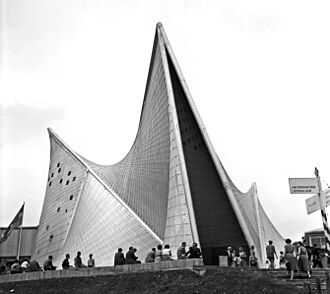Philips Pavilion facts for kids
Quick facts for kids Philips Pavilion |
|
|---|---|

The Philips Pavilion during the 1958 Brussels World's Fair (Expo 58)
|
|
| General information | |
| Type | Pavilion |
| Architectural style | Modernism |
| Town or city | 1020 Laeken, City of Brussels, Brussels-Capital Region |
| Country | Belgium |
| Opened | 1958 |
| Demolished | 1959 |
| Technical details | |
| Material | Reinforced concrete |
| Design and construction | |
| Architect | Iannis Xenakis |
| Architecture firm | Le Corbusier |
The Philips Pavilion (French: Pavillon Philips; Dutch: Philipspaviljoen) was a very special building. It was built for the 1958 World's Fair in Brussels, Belgium. The electronics company Philips asked for this unique design.
Famous architect Le Corbusier and his team designed it. The pavilion was made to show off new technology. It also featured an amazing show of sounds and lights. This celebrated the progress made after World War II.
Contents
A Unique Building for Expo 58
The Philips Pavilion was a great example of Modern architecture. It was built for the 1958 Brussels World's Fair, also known as Expo 58. This fair was a big event. It showed off new ideas and inventions from around the world.
Designing a Modern Marvel
Le Corbusier was a very busy architect. He was working on a big city plan in Chandigarh. So, much of the pavilion's design work went to Iannis Xenakis. Xenakis was also a talented composer. His musical ideas even influenced the building's shape!
The pavilion was made from reinforced concrete. This is a strong building material. It had a very unusual shape. It looked like a cluster of nine "hyperbolic paraboloids." Imagine curved shapes that look a bit like saddles!
Music and Light Inside
Inside the pavilion, visitors experienced a special show. It was called Poème électronique. This show combined music and visuals. The music was created by Edgard Varèse. Sound experts used telephone dials to control the sound. They made the music move around the space. This is called "spatialized" music.
The speakers were placed inside the walls. The walls were covered in a material that gave them a textured look. Varèse planned exactly how the music would travel. He used the pavilion's unique shape and height. As people entered and left, they heard another piece of music. This was Concret PH by Iannis Xenakis. It was a type of music called musique concrète.
A Short-Lived Wonder
The Philips Pavilion was a temporary building. It was designed just for the World's Fair. After the fair ended, the building was taken down. It was demolished on January 30, 1959.
Its Lasting Impact
Even though it was temporary, the Philips Pavilion left a big mark. The European Union helped fund a project. This project created a virtual version of the pavilion. This means you can explore it online!
Some people believe the Warszawa Ochota railway station in Poland was inspired by the Philips Pavilion. This shows how influential its design was.
Construction




